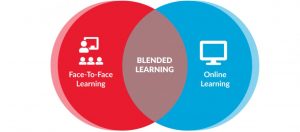Note4Students
From UPSC perspective, the following things are important :
Prelims level: Blended learning
Mains level: Paper 2- Blended learning and related issues
Blended mode of teaching and its advantages

- A recent circular by the University Grants Commission (UGC) proposes that all higher educational institutions (HEI) teach 40% of any course online and the rest 60% offline termed as blended learning (BL).
- The UGC argues that this “blended mode of teaching” and learning paves the way for:
- 1) Increased student engagement in learning.
- 2) Enhanced student-teacher interactions.
- 3) Improved student learning outcomes.
- 4) More flexible teaching and learning environments, among other things.
- 5) Other key benefits such as the increased opportunity for institutional collaborations at a distance and enhanced self-learning accruing from blended learning (BL).
- 6) BL benefits the teachers as well. It shifts the role of the teacher from being a “knowledge provider to a coach and mentor”.
- 7) The note adds that BL introduces flexibility in assessment and evaluation patterns as well.
Challenges
- All India Survey on Higher Education (2019-20) report shows that 60.56% of the 42,343 colleges in India are located in rural areas and 78.6% are privately managed.
- Only big corporates are better placed to invest in technology and provide such learning.
- Second, according to datareportal statistics, Internet penetration in India is only 45% as of January 2021.
- This policy will only exacerbate the existing geographical and digital divide.
- Third, BL leaves little room for all-round formation of the student that includes the development of their intelligent quotient, emotional quotient, social quotient, physical quotient and spiritual quotient.
- The listening part and subsequent interactions with the teacher may get minimised.
- Also, the concept note assumes that all students have similar learning styles and have a certain amount of digital literacy to cope with the suggested learning strategies of BL.
- This is far from true. Education in India is driven by a teacher-centred approach.
Suggestions
- The government should ensure equity in access to technology and bandwidth for all HEIs across the country free of cost.
- Massive digital training programmes must be arranged for teachers.
- Even the teacher-student ratio needs to be readjusted to implement BL effectively.
- This may require the appointment of a greater number of teachers.
- The design of the curriculum should be decentralised and based on a bottom-up approach.
- More power in such education-related policymaking should be vested with the State governments.
- Switching over from a teacher-centric mode of learning at schools to the BL mode at the tertiary level will be difficult for learners.
- Hence, the government must think of overhauling the curriculum at the school level as well.
- Finally, periodical discussions, feedback mechanisms and support services at all levels would revitalise the implementation of the learning programme of the National Education Policy 2020, BL.
- It will also lead to the actualisation of the three cardinal principles of education policy: access, equity and quality.
Conclusion
Government must take steps to address the concerns with blended learning before implementing it.
Get an IAS/IPS ranker as your 1: 1 personal mentor for UPSC 2024
